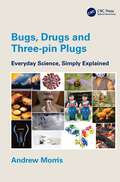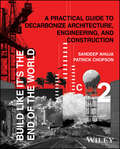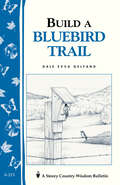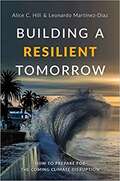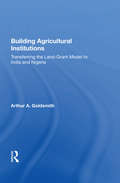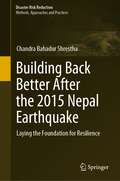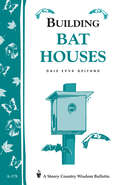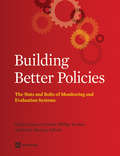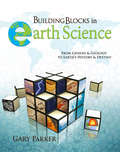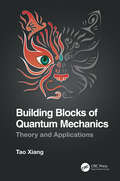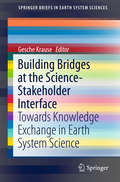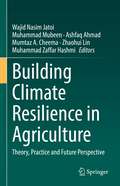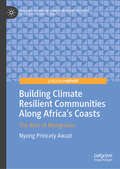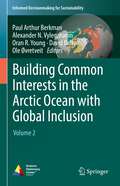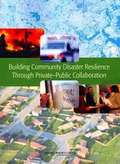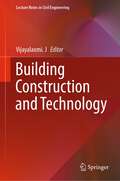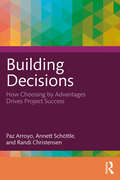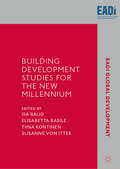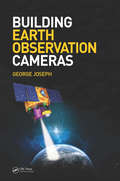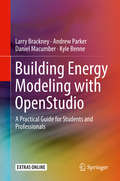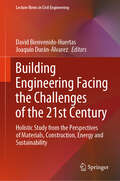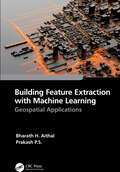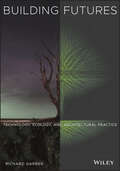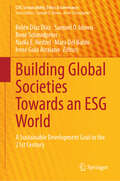- Table View
- List View
Bugs, Drugs and Three-pin Plugs: Everyday Science, Simply Explained
by Andrew MorrisFor the millions who remain curious about the world around them, but gained little from science at school, this book offers a way forward. Based on live discussions with adults from all walks of life, each chapter begins with an everyday experience, like swallowing a pill or watching a bee on a flower. The main scientific ideas underlying each topic are then explored, so that understanding of a set of fundamental concepts builds up gradually throughout the book. In contrast to more traditional approaches to science learning, topics range freely across the subject areas. The story of Covid, for example includes aspects of biology, chemistry, mathematics and social behaviour. Plain English is used throughout and mathematical expressions are avoided. Key points are illustrated with clear diagrams and photographs. By drawing on questions and perspectives of ordinary people, the book offers an introduction to basic ideas in science as a whole, rather than any one particular subject. For the adult wishing to make good a gap in their understanding it provides a starting point for entering the rich world of popular science.
Build Like It's the End of the World: A Practical Guide to Decarbonize Architecture, Engineering, and Construction
by Sandeep Ahuja Patrick ChopsonAuthoritative roadmap to the design and construction of a carbon-positive built environment Build Like It’s the End of the World stands as a compelling manifesto for the AEC industry, confronting the urgent challenges of climate change with actionable solutions. Authored by Sandeep Ahuja and Patrick Chopson, this text embarks on a journey to redefine the future of our built environment. Through a lens of decarbonization, it challenges established norms and introduces a new benchmark for sustainable design and construction. This book not only advocates for a radical shift in design and construction philosophy but also provides a concrete blueprint for achieving carbon-positivity in our projects and practices. The authors bring their extensive experience and research to the forefront, offering a guide that marries rigorous analytical methods with practical applications. It is a call to action, urging professionals and students alike to embrace innovative technologies and strategies that can lead to significant changes in how we conceive and construct our spaces. Within its pages, readers will find: A comprehensive strategy for carbon-positive design: a detailed blueprint showcases step-by-step how sustainable practices can be integrated into projects, drawing on the authors’ vast experience and thorough research. Engaging tools for practical implementation: bridging the gap between high-level sustainability goals and their execution, providing readers with learning objectives, instructional activities, and compelling case studies.Insights on embedding sustainable practices: it offers valuable perspectives on incorporating carbon-positive principles into existing workflows, highlighting the simplicity and profound impact of these efforts.The economic and cultural case for sustainable buildings: demonstrating the viability and necessity of carbon-positive buildings, emphasizing the importance of a cultural shift towards decarbonization in the construction industry. Build Like It’s the End of the World is an essential read for anyone in the AEC field looking to navigate the complexities of decarbonization of buildings. It serves as a powerful testament to the role of technology and strategic innovation in transforming the industry, guiding us towards a future where our buildings play a pivotal role in the health of our planet.
Build a Bluebird Trail: Storey's Country Wisdom Bulletin A-213
by Dale Evva GelfandConservationists across North America are working to help protect and support bluebirds, and you can do your part by creating a bluebird trail. This is simply a series of nesting boxes (anywhere from a few to a few thousand) set about 300 feet apart along a prescribed route. Dale Gelfand tells you what you need to know about bluebirds and their habits, and she shows you how to create and monitor an effective bluebird trail with well-designed nesting boxes.
Building A Resilient Tomorrow: How To Prepare For The Coming Climate Disruption
by Leonardo Martinez-Diaz Alice C. HillClimate change impacts-more heat, drought, extreme rainfall, and stronger storms-have already harmed communities around the globe. Even if the world could cut its carbon emissions to zero tomorrow, further significant global climate change is now inevitable. Although we cannot tell with certainty how much average global temperatures will rise, we do know that the warming we have experienced to date has caused significant losses, and that the failure to prepare for the consequences of further warming may prove to be staggering. Building a Resilient Tomorrow does not dwell on overhyped descriptions of apocalyptic climate scenarios, nor does it travel down well-trodden paths surrounding the politics of reducing carbon emissions. Instead, it starts with two central facts: climate impacts will continue to occur, and we can make changes now to mitigate their effects. While squarely confronting the scale of the risks we face, this pragmatic guide focuses on solutions-some gradual and some more revolutionary-currently being deployed around the globe. Each chapter presents a thematic lesson for decision-makers and engaged citizens to consider, outlining replicable successes and identifying provocative recommendations to strengthen climate resilience. Between animated discussions of ideas as wide-ranging as managed retreat from coastal hot-zones to biological approaches for resurgent climate-related disease threats, Alice Hill and Leonardo Martinez-Diaz draw on their personal experiences as senior officials in the Obama Administration to tell behind-the-scenes stories of what it really takes to advance progress on these issues. The narrative is dotted with tales of on-the-ground citizenry, from small-town mayors and bankers to generals and engineers, who are chipping away at financial disincentives and bureaucratic hurdles to prepare for life on a warmer planet. For readers exhausted by today's paralyzing debates on yearly "fluke" storms or the existence of climate change, Building a Resilient Tomorrow offers better ways to manage the risks in a warming planet, even as we work to limit global temperature rise.
Building Agricultural Institutions: Transferring The Land-grant Model To India And Nigeria
by Arthur A GoldsmithShortly after World War II the United States began to export to developing countries the ''land-grant model"-its system of applied agricultural science. This system is made up of subnational agricultural universities, extension services, and experiment stations, and also of national-level organizations to support and coordinate agricultural develop
Building Back Better After the 2015 Nepal Earthquake: Laying the Foundation for Resilience (Disaster Risk Reduction)
by Chandra Bahadur ShresthaThis book explores the reconstruction after the 2015 Gorkha Nepal earthquake, on the basis of the author’s first-hand experience that has been validated with empirical evidence. Unlike other advocacy and academic literature, the book takes readers close to the ground where the activities took place. This book describes Nepal’s efforts to rebuild private housing from the preparatory to the concluding stages, and the obstacles faced and overcome along the way. It assesses the consequences of the policy level decisions and also examines the relevance, utility and future use of damage assessment surveys that were carried out in the country. In addition, lessons from the housing grant payment through the banking system, impending reasons for housing non-compliance to building standards, experimentation with resilient resettlements and unresolved issue of urban regeneration have been also delved in. The ground realities revealed that the aid architecture requires further carving out. The last three chapters have attempted to capture the macro level picture of the reconstruction and recovery endeavors: contribution to national economy, structural resilience and comparative overview of Nepal’s delivery in global context. As an intimately involved professional with the 2015 Nepal Earthquake, Dr Shrestha is the authority from whom a holistic understanding can be attained regarding the response of Nepal's state and society to the Earthquake. His study will have ramification at national and global scale in handling with inescapable natural calamities. Kanak M. Dixit, Journalist and Heritage ConservationistDr. Shrestha’s book provides rare insight and perspective on the issues and challenges of governance during the complex journey to reconstruction and future resilience, reflecting his long and intense engagement in the post disaster recovery and reconstruction. Vivek Rawal, Director, People-in-Centre, Ahmedabad, India This collection of balanced insightful essays methodically explores topics such as government decisions and aid during the earthquake recovery combining lived experience and a research approach to reveal lessons and future considerations. Loren Lockwood, Former National Coordinator, &n
Building Bat Houses: Storey's Country Wisdom Bulletin A-178 (Storey Country Wisdom Bulletin Ser.)
by Dale Evva GelfandSince 1973, Storey's Country Wisdom Bulletins have offered practical, hands-on instructions designed to help readers master dozens of country living skills quickly and easily. There are now more than 170 titles in this series, and their remarkable popularity reflects the common desire of country and city dwellers alike to cultivate personal independence in everyday life.
Building Better Policies
by Keith Mackay Philipp Krause Gladys Lopez-AcevedoGovernments around the world face ongoing pressures from citizens to provide more and better services, and to do this while restraining taxation levels. This provides the context for government efforts to ensure their policies and programs are as effective, and as efficient, as possible. An emphasis on government performance has led a number of governments to create formal systems for monitoring and evaluating their performance--on a regular, planned, and systematic basis--with the objective of improving it. The focus of this book is on these government monitoring and evaluation (M and E) systems: what they comprise, how they are built and managed, and how they can be used to improve government performance.
Building Blocks In Earth Science: From Genesis And Geology To Earth's History And Destiny
by Gary ParkerDevelop critical thinking skills as you explore what to believe and why you believe it! To understand earth science, it requires “teamwork,” combining the methods and evidences of both science and history. And if you also use the “history book of the world,” the Bible, you can make sense of the Earth’s surface — altered, formed, and weathered over time, the landscapes and vistas we enjoy today. Learn about the: - Structure of the Earth and its atmosphere. - Types of minerals and rocks, the water table, and types of volcanoes - Earth's tornadoes, faults, polarity, magnetism, reeds, folding, hypercanes, deltas, and much more! When you understand the difference in history and science in questions related to our planet, you can more effectively discern the evidences seen in the world around you. Science is an awesome tool for understanding the workings of our world and for applying such knowledge to benefit mankind. “Scientific truth” however is not determined by consensus, compromise, majority vote, popularity, celebrity endorsement, money, media endorsement, or best-selling books — and it is at its best when it is rooted in a worldview
Building Blocks in Earth Science
by Dr Gary ParkerDevelop critical thinking skills as you explore what to believe and why you believe it! To understand earth science, it requires "teamwork," combining the methods and evidences of both science and history. And if you also use the "history book of the world," the Bible, you can make sense of the Earth's surface -- altered, formed, and weathered over time, the landscapes and vistas we enjoy today. Learn about the: Structure of the Earth and its atmosphere. Types of minerals and rocks, the water table, and types of volcanoes Earth's tornadoes, faults, polarity, magnetism, reeds, folding, hypercanes, deltas, and much more! When you understand the difference in history and science in questions related to our planet, you can more effectively discern the evidences seen in the world around you. Science is an awesome tool for understanding the workings of our world and for applying such knowledge to benefit mankind. "Scientific truth" however is not determined by consensus, compromise, majority vote, popularity, celebrity endorsement, money, media endorsement, or best-selling books -- and it is at its best when it is rooted in a worldview that begins with the Bible!
Building Blocks of Quantum Mechanics: Theory and Applications
by Tao XiangThis textbook provides a concise yet comprehensive introduction to the principles, concepts, and methods of quantum mechanics. It covers the basic building blocks of quantum mechanics theory and applications, illuminated throughout by physical insights and examples of quantum mechanics, such as the one-dimensional eigen-problem, the harmonic oscillator, the Aharonov-Bohm effect, Landau levels, the hydrogen atom, the Landau-Zener transition and the Berry phase. This self-contained textbook is suitable for junior and senior undergraduate students, in addition to advanced students who have studied general physics (including classical mechanics, electromagnetics, and atomic physics), calculus, and linear algebra.Key features: Presents an accessible and concise treatment of quantum mechanics Contains a wealth of case studies and examples to illustrate concepts Based off the author's established course and lecture notes
Building Bridges at the Science-Stakeholder Interface: Towards Knowledge Exchange In Earth System Science (SpringerBriefs in Earth System Sciences)
by Gesche KrauseThis book covers the approaches, applied methods and central participatory processes at the science-stakeholder interfaces embedded in the development of the "Earth System Knowledge Platform (ESKP)". The latter is an initiative of the German Helmholtz Association, synthesizing the expertise of the eight Helmholtz research institutions focusing on Earth System Sciences. The contributions showcase the approach of the Alfred Wegener Institute, Helmholtz Centre for Polar and Marine Research (AWI) within the ESKP initiative. Central focus is placed on the question as to which knowledge transfer processes can be employed to foster meaningful approaches based on science-stakeholder dialogues, data products, and/or modelling. The authors suggest that the tools and approaches for enhancing the vital contributions of science to addressing societal challenges warrant further investigation and development.
Building Climate Resilience in Agriculture: Theory, Practice and Future Perspective
by Muhammad Zaffar Hashmi Zhaohui Lin Wajid Nasim Jatoi Muhammad Mubeen Ashfaq Ahmad Mumtaz Akhtar CheemaThis volume discusses the need to adopt Climate-Resilient Agriculture (CRA) practices to address the increasing global impact that climate change has on agricultural productivity and agriculture-dependent communities. This approach applies technological, policy and economic measures to achieve sustainable agricultural growth in the sectors of grain, fruit, vegetable, fiber, feed, livestock, fisheries and forestry, with the ultimate goal of adapting and building resilience to climate change. The book also uses GIS, crop modeling and remote sensing techniques for future climate resilience applications in agriculture, and covers pest control measures that avoid the use of pesticides to boost crop and livestock productivity for improved food security. The book will be of interest to researchers and students in environmental science, climate science, sustainability and agriculture, as well as policy makers and environmental organizations.
Building Climate Resilient Communities Along Africa's Coasts: The Role of Mangroves (Palgrave Studies in Climate Resilient Societies)
by Nyong Princely AwaziThe book "Building Climate Resilient Communities along Africa's Coasts: The Role of Mangroves" highlights the crucial role mangrove ecosystems play in enhancing climate resilience for coastal communities in Africa, which face rising sea levels, intensified storms, and habitat loss. With Africa&’s extensive coastline and dependence on coastal resources, mangroves are essential for protecting communities from environmental stressors, preserving biodiversity, and supporting livelihoods. Each chapter focuses on a specific coastal region in Africa, addressing local challenges, successful case studies, and strategies for integrating mangrove conservation into resilience planning. The book takes an integrative, community-centered approach, combining detailed analyses of mangroves with case studies from across Africa&’s coasts. It emphasizes the importance of understanding the unique ecological and cultural contexts of different regions. Local community engagement in mangrove restoration is covered, highlighting the value of traditional knowledge alongside modern conservation methods. The book also advocates for collaboration among governments, NGOs, and local stakeholders to develop effective policies. By offering actionable recommendations and showcasing the socio-economic benefits of healthy mangrove ecosystems, the book serves as a practical guide for decision-makers and practitioners, aiming to empower communities and inspire action in the fight against climate change and environmental degradation.
Building Common Interests in the Arctic Ocean with Global Inclusion: Volume 2 (Informed Decisionmaking for Sustainability)
by Oran R. Young Paul Arthur Berkman Alexander N. Vylegzhanin David A. Balton Ole Rasmus ØvretveitThis book contains an inclusive compilation of perspectives about the Arctic Ocean with contributions that extend from Indigenous residents and early career scientists to Foreign Ministers, involving perspectives across the spectrum of subnational-national-international jurisdictions. The Arctic Ocean is being transformed with global climate warming into a seasonally ice-free sea, creating challenges as well as opportunities that operate short-to-long term, underscoring the necessity to make informed decisions across a continuum of urgencies from security to sustainability time scales. The Arctic Ocean offers a case study with lessons that are especially profound at this moment when humankind is exposed to a pandemic, awakening a common interest in survival across our globally-interconnected civilization unlike any period since the Second World War. This second volume in the Informed Decisionmaking for Sustainability series reveals that building global inclusion involves common interests to address changes effectively “for the benefit of all on Earth across generations.”
Building Community Disaster Resilience Through Private-Public Collaboration
by National Research Council of the National AcademiesNatural disasters--including hurricanes, earthquakes, volcanic eruptions, and floods--caused over 220,000 deaths worldwide in the first half of 2010 and wreaked havoc on homes, buildings, and the environment. To withstand and recover from natural and human-caused disasters, it is essential that citizens and communities work together to anticipate threats, limit their effects, and rapidly restore functionality after a crisis. Increasing evidence indicates that collaboration between the private and public sectors could improve the ability of a community to prepare for, respond to, and recover from disasters. Several previous National Research Council reports have identified specific examples of the private and public sectors working cooperatively to reduce the effects of a disaster by implementing building codes, retrofitting buildings, improving community education, or issuing extreme-weather warnings. State and federal governments have acknowledged the importance of collaboration between private and public organizations to develop planning for disaster preparedness and response. Despite growing ad hoc experience across the country, there is currently no comprehensive framework to guide private-public collaboration focused on disaster preparedness, response, and recovery. Building Community Disaster Resilience through Private-Public Collaboration assesses the current state of private-public sector collaboration dedicated to strengthening community resilience, identifies gaps in knowledge and practice, and recommends research that could be targeted for investment. Specifically, the book finds that local-level private-public collaboration is essential to the development of community resilience. Sustainable and effective resilience-focused private-public collaboration is dependent on several basic principles that increase communication among all sectors of the community, incorporate flexibility into collaborative networks, and encourage regular reassessment of collaborative missions, goals, and practices.
Building Construction and Technology (Lecture Notes in Civil Engineering #360)
by Vijayalaxmi J.This book highlights various aspects of building construction industry based on data from field studies. It discusses the challenges, methodologies, technological applications in building construction, technology, and management. The book presents new approaches to effective building construction and an understanding of the impact of applications of latest technologies. This book is aimed at researchers and professionals in civil engineering and building engineering management to assist in understanding the domain along with recent applications, the advantages, and practical limitations through real-life case studies. This book is useful for building engineers in understanding the effective use of technology, construction methods, and project delivery systems.
Building Decisions: How Choosing by Advantages Drives Project Success
by Paz Arroyo Annett Schöttle Randi ChristensenDecision-making is critical. Leaders make decisions daily, often hyper-focusing on cost at the expense of value for society and with negative impacts on the environment and the climate. Project teams are poorly equipped to make decisions and prefer to avoid conflicts instead of having a healthy discussion based on different perspectives. We need to learn ways of making decisions that give better outcomes.Building Decisions presents a framework and practical guidelines for everyday decision-making. The authors introduce the reader to a specific decision-making system, Choosing By Advantages (CBA), and explain the CBA Tabular decision-making method. Providing detailed explanations using relatable examples such as choosing a phone and renovating a kitchen, the book also uses case studies of large construction projects from the authors’ professional careers, including a museum in San Francisco, a tunnel in England, and the main railway station in Munich, to explain the CBA method. These varied examples will help the reader to improve their own decision-making process through critical reflection.Written by three curious experts who founded a research lab focusing on decision-making and want the world to make better decisions. Paz, Annett, and Randi have published dozens of peer-reviewed papers and trained multiple practitioners and engineers on how to make collaborative decisions using CBA. They have designed this book to help professionals, leaders, anyone, and everyone make better and more inclusive decisions and achieve better outcomes.
Building Development Studies for the New Millennium (EADI Global Development Series)
by Isa Baud Elisabetta Basile Tiina Kontinen Susanne Von ItterThis book brings together multiple critical assessments of the current state and future visions of global development studies. It examines how the field engages with new paradigms and narratives, methodologies and scientific impact, and perspectives from the Global South. The authors focus on social and democratic transformation, inclusive development and global environmental issues, and implications for research practices. Leading academics provide an excellent overview of recent insights for post-graduate students and scholars in these research areas.
Building Earth Observation Cameras
by George JosephA System Engineer's Guide to Building an Earth Observation CameraBuilding Earth Observation Cameras discusses the science and technology of building an electro-optical imaging system for a space platform from concept to space qualification and in-orbit evaluation. The book provides a broad overview of various Earth imaging systems with specific exa
Building Energy Modeling with OpenStudio: A Practical Guide For Students And Professionals
by Andrew Parker Larry Brackney Daniel Macumber Kyle BenneThis textbook teaches the fundamentals of building energy modeling and analysis using open source example applications built with the US DOE’s OpenStudio modeling platform and EnergyPlus simulation engine. Designed by researchers at US National Laboratories to support a new generation of high performance buildings, EnergyPlus and OpenStudio are revolutionizing how building energy modeling is taught in universities and applied by professional architects and engineers around the world. The authors, all researchers at National Renewable Energy Laboratory and members of the OpenStudio software development team, present modeling concepts using open source software that may be generally applied using a variety of software tools commonly used by design professionals. The book also discusses modeling process automation in the context of OpenStudio Measures—small self-contained scripts that can transform energy models and their data—to save time and effort. They illustrate key concepts through a sophisticated example problem that evolves in complexity throughout the book. The text also examines advanced topics including daylighting, parametric analysis, uncertainty analysis, design optimization, and model calibration. Building Energy Modeling with OpenStudio teaches students to become sophisticated modelers rather than simply proficient software users. It supports undergraduate and graduate building energy courses in Architecture, and in Mechanical, Civil, Architectural, and Sustainability Engineering.
Building Engineering Facing the Challenges of the 21st Century: Holistic Study from the Perspectives of Materials, Construction, Energy and Sustainability (Lecture Notes in Civil Engineering #345)
by David Bienvenido-Huertas Joaquín Durán-ÁlvarezBuilding engineering is a complex and constantly evolving branch. The needs of the XXI century society cause a constant change in construction industry due to the need to achieve sustainable and ecological buildings. This affects all levels and phases of this engineering. Given this circumstance, numerous researchers turn their efforts to find optimal solutions for building engineering. For this reason, in this book a holistic analysis of building engineering is carried out from the perspectives that have a greater weight for sustainability objectives. The book is divided into 6 sections: (i) Building materials, which deals with research related to the most innovative and sustainable building materials; (ii) Design and construction, which deals with existing methodologies and advances in design and construction in construction sector; (iii) Building repair and maintenance, which deals with building repair, maintenance and upkeep techniques; (iv) Energy efficiency, which analyses the latest research on the energy efficiency of buildings and their behaviour in the face of climate change; (v) Sustainability, which analyses the establishment of measures to achieve a more sustainable built environment; and (vi) construction management, which compiles the latest studies in the field of Project manager. The 38 chapters of the book together constitute an advance for the topic of building engineering. The aspects covered in the book are of great interest to various sectors, such as researchers, engineers, architects, legislators and interested parties.
Building Feature Extraction with Machine Learning: Geospatial Applications
by Bharath.H. Aithal Prakash P.S.Big geospatial datasets created by large infrastructure projects require massive computing resources to process. Feature extraction is a process used to reduce the initial set of raw data for manageable image processing, and machine learning (ML) is the science that supports it. This book focuses on feature extraction methods for optical geospatial data using ML. It is a practical guide for professionals and graduate students who are starting a career in information extraction. It explains spatial feature extraction in an easy-to-understand way and includes real case studies on how to collect height values for spatial features, how to develop 3D models in a map context, and others. Features Provides the basics of feature extraction methods and applications along with the fundamentals of machine learning Discusses in detail the application of machine learning techniques in geospatial building feature extraction Explains the methods for estimating object height from optical satellite remote sensing images using Python Includes case studies that demonstrate the use of machine learning models for building footprint extraction and photogrammetric methods for height assessment Highlights the potential of machine learning and geospatial technology for future project developments This book will be of interest to professionals, researchers, and graduate students in geoscience and earth observation, machine learning and data science, civil engineers, and urban planners.
Building Futures: Technology, Ecology, and Architectural Practice
by Richard GarberBUILDING FUTURES An approach to Information Modeling engaging concepts of equality, sustainability, and labor as they relate to environment and architectural practice Building Futures: Technology, Ecology, and Architectural Practice explores how architects, and the buildings and environments we create, can engage future realities, both abstract and readily understood. These range from climate change and public health to advanced ideas about manufacture and construction. The text demonstrates multiple and hybrid paths in which building information modeling (BIM) and outgrowth technological processes including environmental simulation and human-robot interaction can be utilized in today’s contemporary context, expanding the architect’s agency by focusing on a more conceptual, and ecological, basis for our work. Moving beyond a basic understanding of the role of computation in architecture and design, the work shows how to think critically and speculatively about technology’s deeper and more lasting impacts on both architecture and society. Topics covered in Building Futures include: Technology: information modeling and the relationship between computational and real objects, new approaches to coding in architectural design, and direct-to-manufacture workflows Environment: understanding part-to-whole relationships at a variety of scales and the interconnectedness of things, post-subjective architectural approaches to ecology, and new ideas about sustainability Practice: revisiting architecture by remote control in the time of new global challenges, and novel ideas about creativity, authorship, and professionalism Design professionals and practice leaders grappling with the relationship of technology to design pedagogy will use Building Futures to better theorize and execute their architectural vision. Students in upper-level courses studying technique and theory will also find value in the work, which prepares incoming professionals for the major changes that the Architecture, Engineering, and Construction (AEC) industry may undergo in the coming years and decades. “The book prompts us to consider simulating events where architecture and architects could mitigate, redirect or develop contingencies, in relation to the environment, flows of material and capital, and other “things” that operate from the immediate, through to almost geological timescales.” From the Foreword by Robert Stuart-Smith, Director of the Autonomous Manufacturing Lab, University of Pennsylvania
Building Global Societies Towards an ESG World: A Sustainable Development Goal in the 21st Century (CSR, Sustainability, Ethics & Governance)
by Samuel O. Idowu René Schmidpeter Mara Del Baldo Belén Díaz Díaz Nadia E. Nedzel Irene Guia ArraianoThis book provides insightful approaches to how to improve business sustainability. The volume includes an integrated analysis of different relevant aspects of Environmental, Social, and Governance (ESG) and provides an international view of Corporate Social Responsibility (CSR). The book explores these topics with the aim to share ideas and visions for a sustainable future and to provide useful tips for academics, practitioners, and policy-makers in the context of the 2030 Agenda for Sustainable Development of the United Nations.
